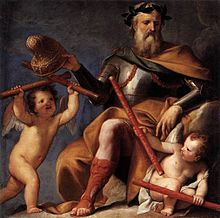Francesco Morosini
Francesco Morosini | |
|---|---|
 Portrait by Giovanni Carboncino | |
| Doge of Venice | |
| In office 1688–1694 | |
| Preceded by | Marcantonio Giustinian |
| Succeeded by | Silvestro Valier |
| Personal details | |
| Born | 26 February 1619 Nauplia , Republic of Venice |
| Spouse | Celibate |
Francesco Morosini (26 February 1619 – 16 January 1694) was the Doge of Venice from 1688 to 1694, at the height of the Great Turkish War. He was one of the many Doges and generals produced by the Venetian noble Morosini family.[1] He is said to have "dressed always in red from top to toe and never went into action without his cat beside him."[2]
Early career

Morosini first rose to prominence as
In 1685, at the outbreak of the Morean War, Morosini took command of a fleet against the Ottomans. Over the next several years, he captured the Morea with the help of Otto Wilhelm Königsmarck, as well as Lefkada and parts of western Greece. He also briefly captured Athens but was unable to hold it, and attempted a failed siege of the former Venetian fortress of Negroponte. His fame reached such heights that he was given the victory title Peloponnesiacus, and was the first Venetian citizen to have a bronze bust placed during his own lifetime in the Great Hall, with the inscription Francisco Morosini Peloponnesiaco, adhuc viventi, Senatus.[3]
Destruction of the Parthenon and loot of sculptures from Athens
During the
When he conquered the Acropolis in early 1688, Morosini attempted to loot Athena's and Poseidon's horses and chariots from the western pediment of the Parthenon, but the sculptures fell on the ground and smashed.[4][5] This was the first documented attempt to remove sculptures from the pediments.[6] The Ottoman Empire regained possession of the monument in the following year and, having noticed the damage, began to sell souvenirs to Westerners.[7]
Morosini also took the Piraeus Lion as a war trophy to the Venetian Arsenal.
Doge
In the summer of 1688, Morosini, now having been proclaimed
Commemoration

- The Scuola Navale Militare Francesco Morosiniis named for him.
- The launchedon 30 July 1885, completed in 1889, and stricken in 1909, was named for him.
- The Francesco Caracciolo-class battleship Francesco Morosini, laid down in 1915 but scrapped in 1921 prior to launching, was named for him.
See also
References
- ^ a b Encyclopædia Britannica, Morosini Family, 2008, O.Ed.
- ^ Jan Morris. The Venetian Empire: A Sea Voyage. (Kindle Locations 976-977). Penguin Books Ltd. Kindle Edition.
- ^ Finlay, George (1856). The History of Greece under Othoman and Venetian Domination. London: William Blackwood and Sons. p. 220.
- ISBN 978-1906509217.
- S2CID 164127076.
- ISBN 978-9004111981.
- ^ Encyclopædia Britannica, Athens, The Acropolis, p.6/20, 2008, O.Ed.
- ^ Image allafinedeiconti.it October 2019

